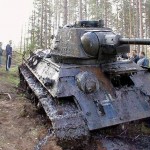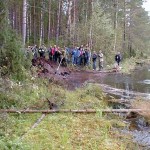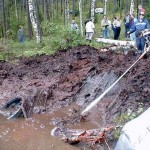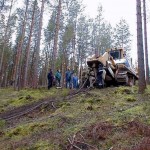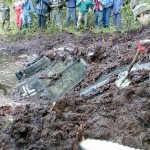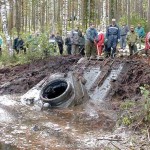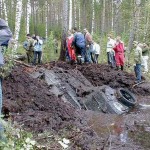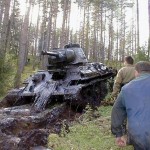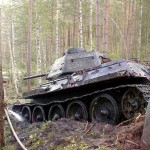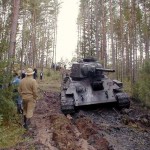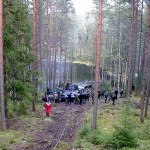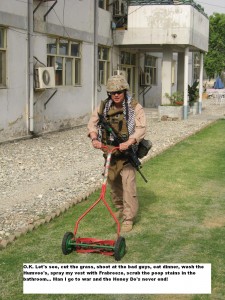March 4th, 2010 Posted in The SandGram v1.0
I love good stories like this one. It was sent to me a year or two ago and I lost it, but like most good internet stories, it comes around again and again. So my buddy Reb, another Marine and WWII buff sent this Tank story to me and I loved it so much that it will go on the site. (Update: This email was taken from Vince Lewis’s website that I have linked below. Trust me when I say that you can spend hours reading all the incredible stories that he has posted there…Lost tanks, lost subs, planes the whole ball of wax! Vince, great job on all the research you put into these stories! Well done Mate!)
The thing I find fascinating is going through junk yards and seeing what you can come up with. My next post will be about the WW II T-34 Russian tank I found in Hereat Afghanistan and the Texan T-6 WW II trainer I found in Iraq. Anyway, I hope that you enjoy this story and the incredible pictures … I also found the origin of this story on Vince Lewis’s website with some more pictures on the tanks and some other links too. http://www.vincelewis.net/t34.html You might like the Youtube video here too.
http://www.youtube.com/watch?v=8kKLbKHNquE
Semper Fi,
Taco
PS Back in the late 80’s, A German farmer died and his wife went to the local police station asking them to remove the Tank in her barn. After the war ended, the husband a King Tiger tank driver, drove his tank home and kept it in his barn. He told his wife he would be ready when the Russian’s attacked. If anyone has any knowledge of this story, email me.
WW II Russian tank with German markings uncovered after 62 years.
WW II Buffs will find this interesting. Even after 62 years (and a little tinkering), they were able to fire up the diesel engine!
A Komatsu D375A-2 bulldozer pulled the abandoned tank from its tomb under the boggy bank of a lake near Johvi, Estonia.
The Soviet-built T34/76A tank had been resting at the bottom of the lake for 56 years. According to its specifications, it’s a 27-ton machine with a top speed of 53km/hr.
From February to September 1944, heavy battles were fought in the narrow, 50 km-wide, Narva front in the northeastern part of Estonia. Over 100,000 men were killed and 300,000 men were wounded there. During battles in the summer of 1944, the tank was captured from the Soviet army and used by the German army.
(This is the reason that there are German markings painted on the tank’s exterior.)
On 19th September, 1944,
German troops began an organized retreat along the Narva front. It is suspected that the tank was then purposefully driven into the lake to conceal it when its captors left the area. At that time, a local boy walking by the lake, Kurtna Matasjarv, noticed tank tracks leading into the lake but not coming out anywhere. For two months he saw air bubbles emerging from the lake. This gave him reason to believe that there must be an armored vehicle at the lake’s bottom. A few years ago, he told the story to the leader of the local war history club ‘Otsing’. Together with other club members, Mr. Igor Shedunov initiated diving expeditions to the bottom of the lake about a year ago. At the depth of 21 feet they discovered the tank resting under a 10 foot layer of peat.
Enthusiasts from the club, under Mr Shedunov’s leadership, decided to pull the tank out. In September of 2000 they turned to Mr. Aleksander Borovkovthe, manager of the Narva open pit company AS Eesti Polevkivi, to rent the company’s Komatsu D375A-2 bulldozer. (Currently used at the pit, the Komatsu dozer was manufactured in 1995, and has recorded 19,000 operating hours without major repairs.) The pulling operation began at 09:00 and was concluded at 15:00, with several technical breaks. The weight of the tank, combined with the travel incline, made for a pulling operation that required significant muscle. The D375A-2 handled the operation with power and style. The weight of the fully-armed tank was around 30 tons, so the active force required to retrieve it was similar. A main requirement for the 68-ton dozer was to have enough weight to prevent slippage while moving up the hill. After the tank surfaced, it turned out to be a “trophy tank” that had been captured by the German army in the course of the battle at Sinimaed (Blue Hills) about six weeks before it was sunk in the lake. Altogether, 116 shells were found on board. Remarkably, the tank was in good condition, with NO RUST, and all systems (except the engine) in working condition. This is a very rare machine, especially considering that it fought both on the Russian and the German sides. Plans are underway to fully restore the tank. It will be displayed at a war history museum in the Gorodenko village on the left bank of the River Narv.
Tags: German, Lost and Found, Russian Tank, WWII
